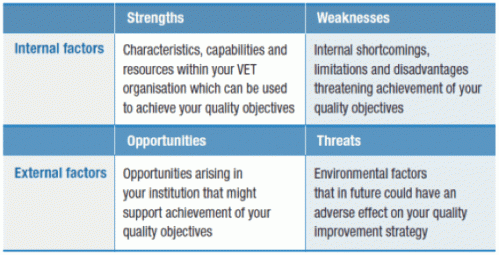Strengths, weaknesses, opportunities and threats (SWOT) analysis provides an overall framework for identifying strengths and weaknesses of a VET institution and opportunities and threats for its strategic development. It is a methodological tool for developing a coherent strategy for the whole institution based on valid assessment and reliable evaluation of both internal and external factors influencing your organisation. The tool can provide a condensed overview of an organisation’s situation based on the more detailed analyses undertaken in the previous stages of the PDCA cycle.
While your former analyses have focused on your internal achievements, a SWOT analysis aims at combining internal assessment findings with results of an investigation on the external preconditions for further development of your VET institution. Inward-looking analysis of strengths and weaknesses aims to illuminate where failures must be corrected and which strengths could be further developed.
Figure 13. Strategic significance of a SWOT analysis

Source: CEDEFOP.
Analysis of external factors should identify opportunities and threats the organisation might face in the future. Thus, a SWOT analysis is an appropriate tool to transform results of internal assessments and analysis of future trends into a coherent development strategy for your institution, including a strategy for continuous improvement of quality.
Table 3. Components of a SWOT analysis

Source: CEDEFOP.
A SWOT analysis is a sober and open-ended investigation into the current and future situation of an institution, which includes analysis of empirical facts and data on persistent trends for VET in Europe and in your particular region. Relevant studies and research reports should be evaluated, but contacts with experts, research institutions and development agencies should be favoured as well. Once the major opportunities and threats are identified, their potential impact on the institution has to be evaluated. The crucial step is to link internal and external factors: a SWOT analysis aims to identify which development strategy will best enable an institution to take full advantage of the opportunities – with regard to its particular strengths and weaknesses.
Unique strengths are particularly well-suited key factors for further development, so focus your strategy on the strengths that distinguish your institution from others (see also Section 3.5.2 on benchmarking).
Like other quality-oriented activities, SWOT analysis and subsequent strategy building should be carried out in partnership with internal and external stake holders. Applying this approach should allow you to integrate experiences from different economic and social segments of society in establishing your development strategy. Including a broad variety of experts and stakeholders from different backgrounds means organising this process as a multiphase circle, similar to the PDCA cycle, with individual stages considering tangible data as well as intangible knowledge of participants, shared analysis and reflection, drawing appropriate conclusions for further action and thus continuously shaping your development strategy (see Figure 14).
Figure 14. Shaping a development strategy

Source: CEDEFOP.
Ideally, each passage round the cycle should help to build a clearer picture of the empirical situation and future trends and thus optimise the development strategy. If planning is organised as a common learning process, it is not only quality of the strategy that will benefit. Through common exchange of experience and joint production of new insights cooperative relationships of the actors will also intensify and a climate of common trust will emerge.
Owing to growing requirements for innovation in VET, quality development is not making linear progress but is rather a multidimensional task. VET institutions have to adapt continuously to increasingly rapid changes in the business world and to constantly altering demand for new skills and competences in labour markets. Thus, strategic quality development means reiterating the cycle again and again, being ready to learn, adapt and innovate.
Identifying new external trends and demand in labour markets and ensuring appropriate response from your organisation is a continuous challenge. But not every new direction will suit your organisation and match your particular strengths. You should first thoroughly analyse external developments’ significance for your organisation’s strategy and then undertake a series of adaptation and change activities to bring your strategic insights down to earth – into your particular profile and into delivery of the VET programmes you offer (see Figure 15).
Figure 15. Adapting your strategy

Source: CEDEFOP.
New VET programmes might need to be designed and existing ones might need to be adapted and changed as regards both content and methods of delivery.
Planning teaching and learning processes will follow – new staff, equipment and learning material might be needed.
Delivery of adapted and new programmes must be organised.
Monitoring and measuring results, analysis and further improvement must be ensured.